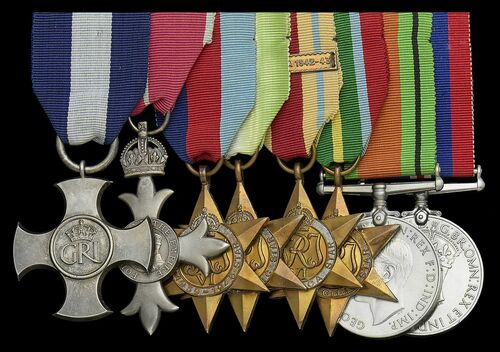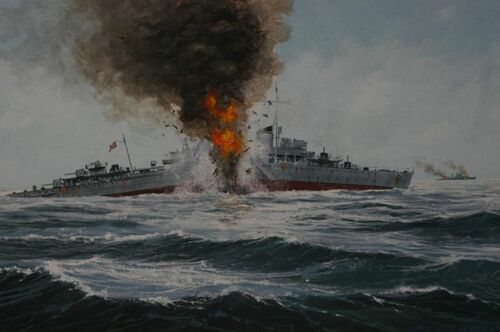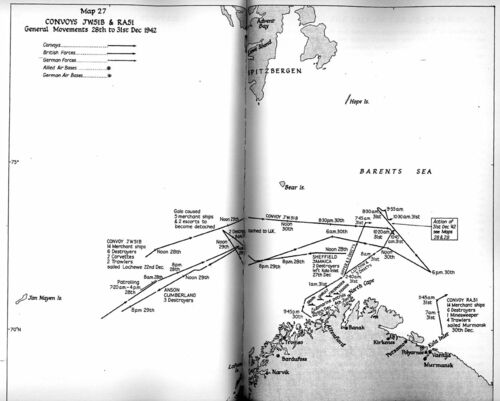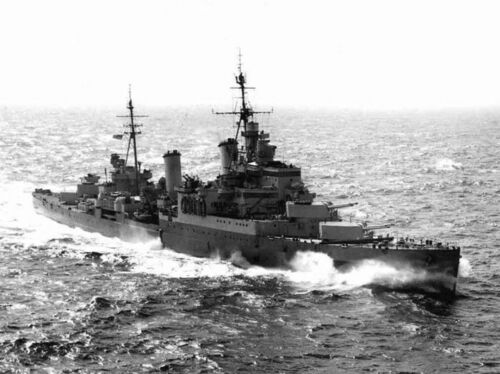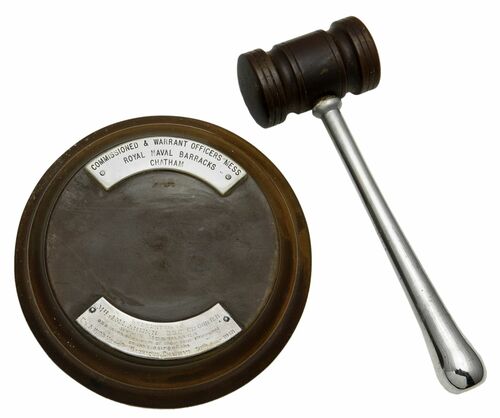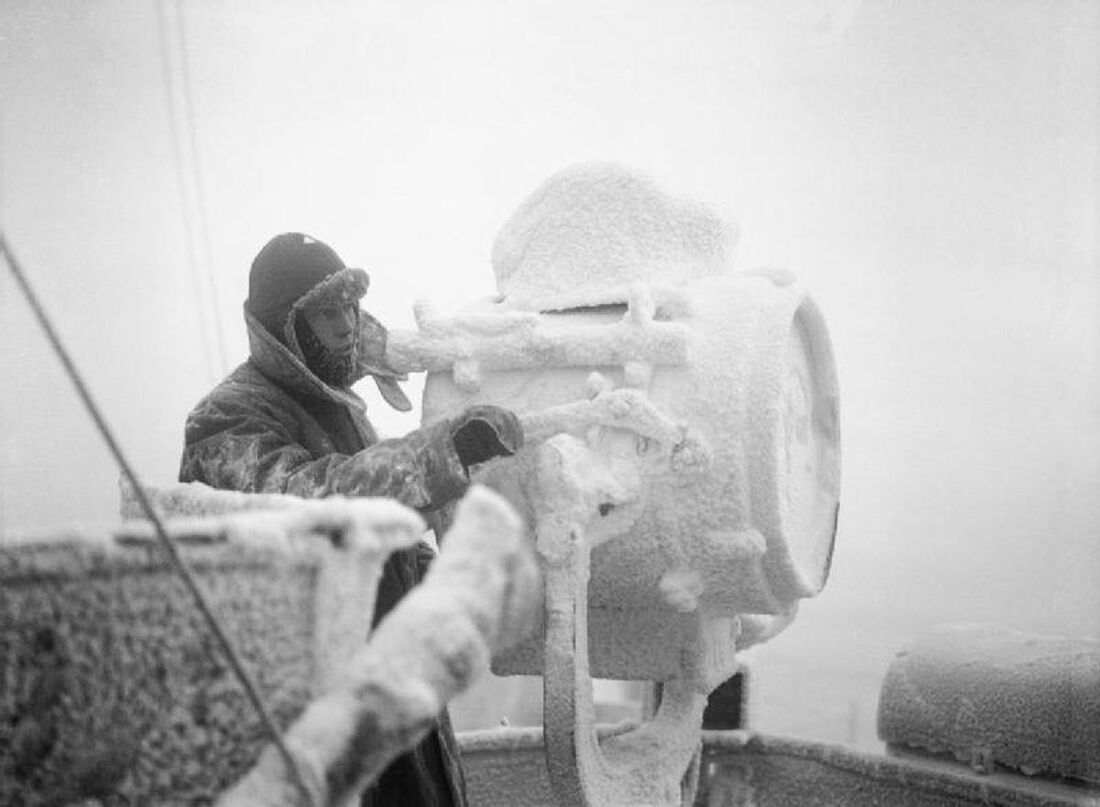Auction: 24001 - Orders, Decorations and Medals
Lot: 121
(x) A 1949 M.B.E. and 1943 D.S.C. group of eight awarded to Commander (Gunner) J. M. Larder, Royal Navy, who shared in the Arctic Convoys and the Battle of the Barents Sea aboard the Sheffield, on which occasion she sank the Friedrich Eckholdt
Distinguished Service Cross, G.VI.R., the reverse officially dated '1943', hallmarks for London 1942; The Most Excellent Order of the British Empire, 2nd Type, Military Division, (M.B.E.) Member's breast Badge, silver; 1939-45 Star; Atlantic Star; Africa Star, clasp, North Africa 1942-43; Pacific Star; Defence and War Medals 1939-45, mounted as worn in this order, good very fine (8)
M.B.E. London Gazette 1 January 1949.
D.S.C. London Gazette 2 June 1943. Invested at Buckingham Palace on 16 March 1945.
John Mawer Larder was born at Lincoln on 8 October 1903 and was a shop assistant upon his joining the Royal Navy on 20 October 1920. Promoted Acting Gunner by 1 October 1933, he served aboard Sheffield from 30 September 1940 as a Gun Direction Finder. Sheffield would find herself heavily engaged in the Arctic Convoys, hardships that Larder no doubt shared. During the summer of 1942 she was part of the 'Torch' landings and was also present during the Battle of the Barents Sea on 31 December 1942.
Battle of the Barents Sea
Towards the end of 1942 the Admiralty adopted the tactic of breaking convoys to Russia into smaller groups. Thus JW51A was the first half of a convoy which reached Kola Inlet on Christmas Day 1942; it was quickly followed by the other half, JW51B. The awful severity of the Arctic weather in winter, it was hoped, would reduce the danger of attacks by U-boats and aircraft.
The convoy, consisting of fourteen merchant ships, was escorted by six destroyers and five smaller warships under the command of Captain R. St V. Sherbrooke in the Onslow. On 27 December the cruisers Sheffield (flying the flag of Rear-Admiral R.L. Burnett) and Jamaica sailed from Kola to meet the convoy. That same day a severe gale struck and partly scattered the ships, although most succeeded in re-joining the convoy.
On 30 December U-354 sighted the convoy to the south of Bear Island and reported its presence. A powerful German squadron sailed from Alten Fjord in Norway to intercept; it consisted of the heavy cruiser Admiral Hipper (flying the flag of Vice Admiral Kummetz), the pocket battleship Lützow and six destroyers. The Hipper was a ship of 12,500 tons, armed with eight 8-inch guns; the Lützow was slightly larger, at 12,750 tons, with a similar armament and the two ships were far more powerful than the two British cruisers.
The German force divided in two to attack the convoy, Hipper from the north and Lützow from the south. Burnett's cruisers had not yet established contact and a day of utter confusion developed in atrocious weather conditions.
At 08:30hrs on the 31st Obdurate reported the presence of strange destroyers to the rear of the convoy. Sherbrooke sent her to investigate, at the same time he sent his own ship's company to breakfast and ordered them to change into clean underclothing. It must have been one of the very few occasions during the Second World War when that traditional order was given. At 09:39hrs Onslow sighted Hipper to the north of the convoy. Over the following hour Onslow and another destroyer skirmished with the cruiser, slipping in and out of the smoke screens and threatening her with their torpedoes. To begin with Hipper's gunnery was uncertain but at around 10:20hrs Onslow was hit several times by 8 inch shells. Within a few minutes the ship was in a critical condition; A and B guns were out of action, the ship was holed in the engineroom, serious fires were raging, and more than forty of her company were dead or wounded. The casualties included Captain Sherbrooke who was hit in the face by a shell splinter and nearly blinded; he refused to leave the bridge until satisfied that the commander of Obedient had taken over from him.
While this battle was in progress Lützow approached the convoy from the south; only the snow squalls which shielded the ships and the timidity of the battleship's captain saved the convoy from annihilation. Again, at around 11:00hrs both the Hipper and Lützow approached the convoy and were held off only by the threat of torpedoes from the hard-pressed destroyers. The destroyer Achates was crippled but continued to fight for another two hours before sinking.
At 11:36hrs the cruisers Sheffield and Jamaica arrived on the scene and opened fire on Hipper, inflicting considerable damage. Two German destroyers, which had been detached to sink the minesweeper Bramble, misidentified the British cruisers for German ships and attempted to form up on them. Sheffield opened fire on the leading ship, the Friedrich Eckholdt, at a range of 4,000 yards; the German commander sent a message to Hipper:
'You are firing on me.'
Astern, the awful truth dawned and the Richard Beitzen sent a hurried message to her flotilla leader:
'No. It is an English cruiser.'
It was too late however, and the Sheffield fired on her with everything from her main 6-inch guns down to her anti-aircraft pom-poms. A Midshipman recalled:
'A number of us were permitted to leave the turret and go out on deck to see this dark grey wreck of a vessel a short distance away, some 2-300 yards at most, listing over with her hull exposed and with fires burning at various points along her deck, so slowly passing down our ship's side. The upper deck short-range weapons raked the burning deck with gunfire as she drifted astern of us into the darkness and oblivion. I cannot remember seeing any movement nor signs of life aboard … It was an eerie and to my mind ghostly vision, unreal, as though in a black-and-white film, but the flames already dying as they were, seemed to illustrate the … finality of a gallant foe.'
No doubt Larder gave his all during this famous action and it in no small order contributed to the award of his first decoration. He had been made Commander (Gunner) in October 1942 and remained on the active list, being made Lieutenant in July 1948. He retired in July 1953 and died at Chatham in May 1990; sold together with the forwarding document for his M.B.E., this named 'Lieutenant John M. Larden, M.B.E., D.S.C. Royal Navy.' and presentation gavel and block, the latter with engraved plaques stating:
'Commissioned & Warrant Officers Mess Royal Naval Barracks Chatham
Presented to Mr J M Larder DSC Cd. Gnr. R.N. by his Messmates as a token of their last President on the closing of the Cd. & W.O.s Mess R.N. Barracks Chatham 30th June 1948.'
For his miniature dress Medals, please see Lot 350.
Subject to 5% tax on Hammer Price in addition to 20% VAT on Buyer’s Premium.
Estimate
£2,400 to £2,800
Starting price
£2200

